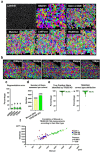A new bio imagery user-friendly tool for automatic morphometry measurement on muscle cell cultures and histological sections
- PMID: 38326394
- PMCID: PMC11269594
- DOI: 10.1038/s41598-024-53658-0
A new bio imagery user-friendly tool for automatic morphometry measurement on muscle cell cultures and histological sections
Abstract
TRUEFAD (TRUE Fiber Atrophy Distinction) is a bioimagery user-friendly tool developed to allow consistent and automatic measurement of myotube diameter in vitro, muscle fiber size and type using rodents and human muscle biopsies. This TRUEFAD package was set up to standardize and dynamize muscle research via easy-to-obtain images run on an open-source plugin for FIJI. We showed here both the robustness and the performance of our pipelines to correctly segment muscle cells and fibers. We evaluated our pipeline on real experiment image sets and showed consistent reliability across images and conditions. TRUEFAD development makes possible systematical and rapid screening of substances impacting muscle morphology for helping scientists focus on their hypothesis rather than image analysis.
© 2024. The Author(s).
Conflict of interest statement
The authors declare no competing interests.
Figures





References
-
- Stewart, G. J. The Skeletal and Muscular Systems (Facts on File, Incorporated, 2009).
MeSH terms
Grants and funding
LinkOut - more resources
Full Text Sources

